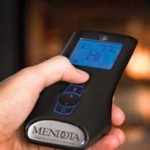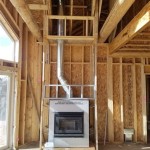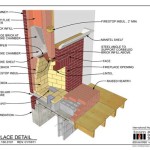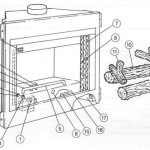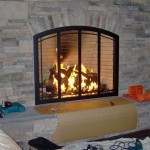Understanding Non-Vented Fireplace Glass: Functionality and Safety
Non-vented, or ventless, fireplaces offer a modern and convenient alternative to traditional wood-burning and vented gas fireplaces. A critical component of these systems is the non-vented fireplace glass, often referred to as ceramic glass. This specially engineered glass plays a crucial role in the fireplace's overall safety, efficiency, and aesthetic appeal. Understanding the properties and functions of this glass is essential for anyone considering or currently using a non-vented fireplace.
Unlike traditional fireplaces that require a chimney or vent to expel exhaust gases, ventless fireplaces are designed to burn fuel cleanly and efficiently, minimizing the production of harmful byproducts like carbon monoxide. The efficiency of this combustion process is heavily reliant on the design of the burner and the proper functioning of all fireplace components, including the glass. The glass serves not only as a visual barrier but also as an integral part of the combustion process, affecting heat radiation and air circulation within the firebox.
The selection of appropriate non-vented fireplace glass is paramount. Not all glass is created equal, and using standard window glass or improperly tempered glass in a ventless fireplace can be extremely dangerous. The intense heat generated by these fireplaces requires a specialized glass that can withstand extreme temperature fluctuations without cracking, shattering, or distorting. This specialized glass is typically made of a high-temperature borosilicate ceramic or a similar heat-resistant material.
The Importance of Heat-Resistant Materials
The primary function of non-vented fireplace glass is to contain the fire while allowing heat to radiate outward. This seemingly simple task requires a material capable of withstanding significant thermal stress. Standard glass, even tempered glass intended for windows, is not designed for the extreme temperatures reached within a ventless fireplace. These temperatures can easily exceed 500 degrees Fahrenheit, a level that would cause standard glass to weaken, crack, and potentially shatter. The risk of shattering poses a significant safety hazard, potentially causing burns and property damage.
Ceramic glass, specifically designed for fireplace applications, possesses a much higher thermal shock resistance. Thermal shock refers to the ability of a material to withstand sudden and drastic temperature changes without fracturing. This resistance is achieved through the material's specific composition and manufacturing process. The glass undergoes a special heat treatment that strengthens its internal structure, making it less susceptible to thermal stress. Borosilicate glass, for example, is known for its low coefficient of thermal expansion, meaning it expands and contracts less than standard glass when subjected to heat. This reduced expansion minimizes stress and prevents cracking.
The selection of the correct thickness of the glass is also crucial. Thicker glass generally offers greater strength and heat resistance. However, excessive thickness can also impede heat radiation and reduce the efficiency of the fireplace. Manufacturers typically specify the appropriate glass thickness for each fireplace model, and it is essential to adhere to these specifications to ensure safe and optimal performance.
Furthermore, some non-vented fireplace glasses are treated with special coatings to enhance heat reflection and radiation. These coatings can improve the fireplace's overall efficiency by directing more heat into the room. The coating also helps with maintaining a consistent surface temperature across the glass. This is particularly important when children or pets are present, as it lowers the risk of accidental burns upon contact with the glass surface.
Ensuring Proper Installation and Maintenance
Even the highest quality non-vented fireplace glass will fail if it is not installed and maintained correctly. Proper installation is critical to ensure that the glass is securely mounted and that it is not subjected to undue stress. The glass should fit snugly within the fireplace frame, but it should not be forced or overly tightened. Over-tightening the mounting hardware can create stress points that weaken the glass and increase its susceptibility to cracking.
Before installing new fireplace glass, it is essential to carefully inspect the frame for any damage or irregularities. Bent or warped frames can put uneven pressure on the glass, leading to premature failure. If the frame is damaged, it should be repaired or replaced before the glass is installed. Likewise, be sure to use proper gasket or other sealing material to create an airtight seal between the glass and the frame. A poorly sealed glass panel can allow air leaks, which can disrupt the combustion process and reduce the fireplace's efficiency.
Regular maintenance is equally important for prolonging the lifespan of non-vented fireplace glass. The glass should be cleaned periodically to remove ash, soot, and other debris that can accumulate on the surface. Use a specialized fireplace glass cleaner that is designed to remove stubborn deposits without scratching or damaging the glass. Avoid using abrasive cleaners or scouring pads, as these can permanently damage the glass surface. During cleaning, inspect the glass for any signs of cracks, chips, or other damage. Even minor damage can weaken the glass and make it more prone to failure. If any damage is detected, the glass should be replaced immediately.
Another key aspect of maintenance is ensuring that the fireplace is properly ventilated. While non-vented fireplaces do not require a chimney, they do require adequate airflow within the room to ensure complete combustion. Obstructing air vents or closing doors and windows can reduce airflow and lead to incomplete combustion, which can produce excessive soot and carbon monoxide. Follow the manufacturer's recommendations for proper ventilation and never operate the fireplace in a poorly ventilated space.
It's also important to only use the fuel type specified by the fireplace manufacturer. Using the wrong type of fuel can lead to incomplete combustion and increased soot buildup, which can damage the glass and other fireplace components. For example, using liquid propane in a fireplace designed for natural gas (or vice-versa) will result in improper operation and potentially hazardous conditions.
Safety Considerations and Potential Hazards
While non-vented fireplaces offer numerous advantages, it's crucial to be aware of the potential safety hazards associated with their operation. The primary concern is the risk of carbon monoxide poisoning. Carbon monoxide is an odorless, colorless gas that is produced when fuels like natural gas or propane are burned incompletely. In a properly functioning ventless fireplace, the combustion process should minimize carbon monoxide production. However, factors such as poor ventilation, improper fuel usage, or malfunctioning components can increase the risk of carbon monoxide buildup.
To mitigate this risk, it's essential to install carbon monoxide detectors in the home, particularly near the fireplace. These detectors will alert occupants to the presence of dangerous levels of carbon monoxide, allowing them to take corrective action, such as ventilating the room and seeking medical attention. Carbon monoxide detectors should be tested regularly to ensure that they are functioning properly. The batteries should be replaced at least once a year, or more frequently if recommended by the manufacturer.
Another safety consideration is the surface temperature of the fireplace glass. While the specialized glass used in non-vented fireplaces is designed to radiate heat, it can still become extremely hot during operation. Contact with the hot glass can cause severe burns. To prevent accidental burns, it's important to keep children and pets away from the fireplace while it is in use. Fireplace screens or guards can provide an additional barrier to prevent contact with the hot glass. Explain to children the dangers of touching the fireplace glass and supervise them closely when the fireplace is in operation.
Furthermore, be aware of the potential for oxygen depletion in the room. Burning fuel consumes oxygen, and in a tightly sealed room, the oxygen level can decrease to a point where it causes discomfort or even health problems. Symptoms of oxygen depletion include headache, dizziness, and shortness of breath. To prevent oxygen depletion, ensure that the room is adequately ventilated while the fireplace is in use. Open a window or door slightly to allow fresh air to circulate. Consider installing an oxygen depletion sensor, which will shut off the fireplace if the oxygen level drops below a safe threshold.
Finally, always follow the manufacturer's instructions for the safe operation and maintenance of the non-vented fireplace. These instructions provide valuable information about proper fuel usage, ventilation requirements, and maintenance procedures. Ignoring these instructions can increase the risk of fire, carbon monoxide poisoning, and other hazards. Keep the user manual readily accessible and refer to it whenever you have questions about the fireplace's operation.
In conclusion, Non-vented fireplace glass is more than just a visually appealing component, it's a safety feature. Understanding its properties and ensuring its proper installation and maintenance are crucial for the safe and efficient operation of a ventless fireplace. Following the guidelines outlined will contribute to a safer and more enjoyable experience with your non-vented fireplace.
:max_bytes(150000):strip_icc()/ventless-gas-fireplaces-4160746-hero-f9d4bdcd9bd446eb84406de306f790ba.jpg?strip=all)
How To Pick Out A Ventless Gas Fireplace

Ventless Gas Fireplace Vent Free Modern

What Is A Ventless Gas Fireplace Experts In Gaithersbutg Md

Vent Free Gas Fireplaces Inserts Stoves Napolis Godby Hearth And Home

Rh Peterson 30 Inch Contemporary Vent Free Glass Fireplace Burner Fine S Gas

Superior Vrl4543 Ventless See Through Linear Gas Fireplace 43 Woodland Direct

18 Inch See Thru Contemporary Vent Free Glass Burner

Ventless Gas Fireplace Propane

Ventless Gas Fireplace Maintenance Guide Fireplaces Direct Learning Center

Superior Fireplaces 42 Vent Free Firebox Fine S Gas
Related Posts

